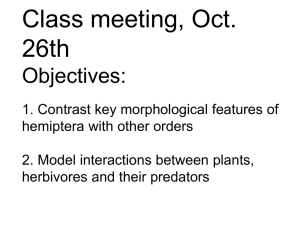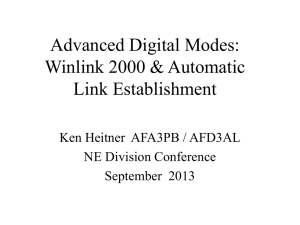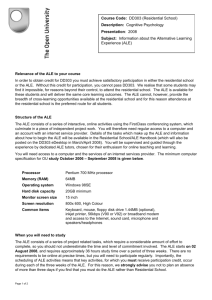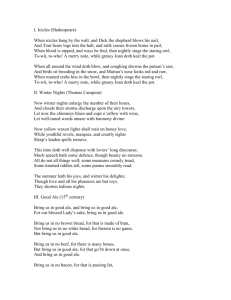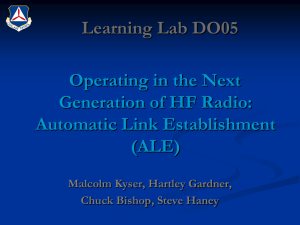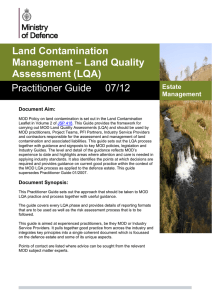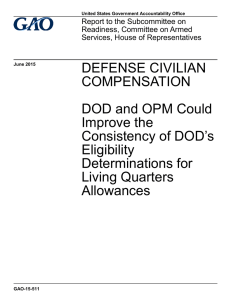AN/PRC-150C - Platoon Box
advertisement
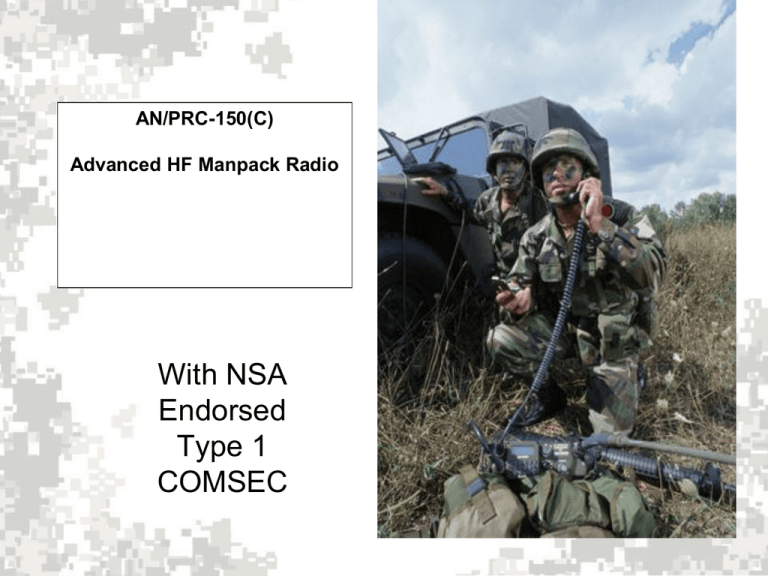
AN/PRC-150(C) Advanced HF Manpack Radio With NSA Endorsed Type 1 COMSEC BC-312 19MK2 30S1 RBB R392 2 KWM-2 3 IMPROVED HIGH FREQUENCY (IHFR) RADIO SETS AN/PRC-104-MANPACK 2-30 MHZ AM SSB-20WATTS RANGE- 30 PLUS MILES AN/GRC-213 MANPACK/VEH. 20 WATTS RANGE- 30 PLUS MILES AN/GRC-193 VEHICLE 100/400 WATTS RANGE- 50-200 MILES 4 WHAT IS HF ?? 5 HOW THEY ARE DIVIDED.. 6 WAVES?? 7 LET’S BEND THE SIGNAL 8 LAYER UPON LAYER 9 WHERE DID THEY GO? 10 SOLAR FLARES :\SpaceWeather.com 11 VOACAP PROP ANALYSIS VOACAP Prop Analysis 12 KEY CAPABILITIES AN/PRC-150(C) Advanced HF Manpack Radio With NSA Endorsed Type 1 COMSEC 13 Key Capabilities • • • • • • • • • HF SSB: 1.6 – 29.9999 MHz VHF FM 30 – 59.9999 MHz Interoperability modes Type I COMSEC Removable Keypad/Display PLGR interface SSB Scan Software defined radio20 watt Manpack Includes programming software and Tactical Chat software • Internal antenna tuner for ground tactical 14 antennas GENERAL DESCRIPTION AN/PRC-150 • 200 Channel Presets, 000 - 199 – – – – Fix Mode can use all 200 ALE Mode uses 000 – 099 3G Mode uses 100 – 162 000 is the manual scratchpad channel • 75 System Presets – Any combination of the four modes – System Preset combine COMSEC Type and TEK, MODEM and Voice modes applied to radio operating mode. • 20 HOP Channel Presets •15 20 DATA MODEM Presets – Waveform Type, speeds and interface GENERAL DESCRIPTION AN/PRC-150 • Two radios in one box – HF-SSB (USB) Radio for Beyond Line of Sight (BLOS) – VHF-FM for Line of Sight (LOS) • 1.6000 MHz to 59.9999 MHz overall frequency range – 1.6 – 29.9999 MHz – USB-HF – 30.0 – 59.9999 MHz – VHF-FM • Four Basic Modes of Operation 16 – FIX – HOP GENERAL DESCRIPTION AN/PRC-150 FIX Mode • 200 Channel Presets – 000 – 199 – 000 – Manual Scratchpad Channel – Fix Mode channels used in ALE plans • Selectable Modulation Types: – USB or LSB – USB is Military Standard – CW • MCW or CW – AME – FM • PT or CT 17 – CLR or Digital Voice Modes GENERAL DESCRIPTION AN/PRC-150 Features • Embedded Type I COMSEC – – – – ANDVT-HF - KY-99A VINSON - KY-57/58 for VHF-FM KG-84C ANDVT-BD - KY-100 • Automatic Tuning Antenna Coupler 18 – Tunes to whips, dipoles or random length wire antennas – Tunes on initial Push to Talk (PTT) – Matches 50 Z ohm transmitter to antenna GENERAL DESCRIPTION AN/PRC-150 Features • Operator-adjustable transmit power levels (low, medium, or high). – HF-SSB Modes – 1, 5 or 20 Watts PEP – VHF-FM – 1, 5, or 10 Watts PEP – Transparent operation with Harris Power Amplifiers of 125, 150 and 400 watts. • Supports MIL-STD-188-141A HF-ALE. 19 – Compatible with other manufacturers following the standard – Automates HF operation by automatically determining the best possible frequency at the GENERAL DESCRIPTION AN/PRC-150 Features • Utilizes a 3.6 VDC HUB to maintain programmed information when the manpack radio is powered OFF. – 1 year rated life – Replace more often if required • Overseas Deployments • Long-term high priority Missions • Radio loses COMSEC and programmed info every time the radio is turned off • 2.9 – 3.0 VDC LOW HUB WARNING 20 – Replace if BIT shows an A4 02 fault code or “Low Hub Voltage” error message appears GENERAL DESCRIPTION AN/PRC-150 Features • Utilizes a 3.6 VDC HUB to maintain programmed information when the manpack radio is powered OFF. – – – – 21 NSN: 6135-01-435-4921 SAFT: LS14250 TOSHIBA: ER3V OR ER4V RADIO SHACK: 23-026 GENERAL DESCRIPTION COMSEC – FILL Devices: • COMSEC Fill - TEKs and KEK can be manually filled from the following devices: – AN/CYZ-10 Data Transfer Device (DTD) (DS-101) using Fill user application software – AN/CYZ-10 Data Transfer Device (DTD) (DS-102) using RDS user application software – KOI-18 General Purpose Tape Reader (DS-102) – KYK-13 Electronic Transfer Device (DS-102) 22 – KYX-15 (DS-102) Net Control Device (NCD) GENERAL DESCRIPTION AN/PRC-150 Features • MELP (Mixed Excitation Linear Prediction) – – – – NSA State of the Art digital Voice Mode Two Speeds, ME2400 and ME600 More robust and better voice quality over LPC-10 Optimal AN/PRC-150 to AN/PRC-150 voice communications – Receiving station “autobauds” to that of sending station • Supports LPC-10 digitized voice: (KY-99) 23 – DV2400 or DV600 – Increased robustness over CLR voice using serial tone waveforms BASIS OF ISSUE 1 10530-0460-01 Manpack Backpack (5895-01-436-3367) 8 RF-6551H Tactical Chat (No NSN) 2 RT-1694D(P)C/U Receiver/Transmitter 5820-01-496-3523) 9 10535-0775-A006 Programming Cable (5995-01-513-2550) 3 10513-4800-02 Battery Box (6160-01-468-0685) 10 919-5004-03 CW Key (5805-01-393-8287) 4 10075-1399 Handset (5965-01-463-7915) 11 10372-0240-02 Manpack Antenna Kit (5999-01-432-5004) 5 10511-0704-012 KDU Extension Cable 6FT. (6145-01-461-5300) 12 10303-1008-01 Ground Stake Kit (5985-01-423-6221) 6 B41-0010-004 Lithium Battery (6135-01-525-9943) 13 10515-0103-4100 Operations Manual (No NSN) 7 RF-6550H Radio Programming Application (7030-01-519-6021) 14 10372-1230 Cable for CW Key (5935-01-437-5903) 1 3 13 11 2 10 6 7 5 9 14 4 8 24 12 HF Radio Programming Application • Management system for AN/PRC-150(C) • Automates network configuration – Network setup – Validation – Key management (for Citadel crypto) – Radio and message terminal setup 25– Loads radios – Win 2000 and XP TACTICAL CHAT • Included with AN/PRC-150(C) • Runs on Windows 98, 2000, and XP • Short messages over radio • File transfer capability • Efficient and fast •26 Similar to AOL Instant Controls/Indicators GPS ANT Connector J2 Data Connector J3 27 Fill J8 Audio Connector J1 HF ANT Connector J7 LCD KDU Function Switch Accessory Connector J6 Ground Post Utility Functions/Self-Test Objectives After completing this module, the student will be able to: • Perform backlight adjustment. • Perform retune of the coupler. • Demonstrate the ability to set radio options. • Perform radio self-test. • Perform battery test. • 28Perform VSWR measurement. Automatic Link Establishment (ALE) 29 Operation ALE Fundamentals • Automatic Link Establishment (ALE) is a technique that permits HF radio stations to call and link on the best HF channel automatically without operator assistance. • ALE systems make use of recently measured radio channel characteristics stored in a memory matrix. • The system works much like a telephone in that each radio in a network is assigned an address (ID). When not in use, each radio receiver constantly scans through its assigned frequencies, listening for calls addressed to itself. 30 Operation ALE Fundamentals SELF ADDRESS - identifies a radio. Each radio can have up to 20 self addresses. The AN/PRC-150 requires at least one 1 to 3 character self addresses to form the LQA matrix. INDIVIDUAL ADDRESSES - identifies other individual stations in the network. ALE allows storage of up to 200 individual addresses. NET ADDRESSES - identifies a group of individual stations which can be called together. ALE supports up to 20 net addresses. 31 Operation ALE Fundamentals • CHANNEL GROUP - listing of channels that were programmed in SSB mode which will be used as part of the ALE configuration. Maximum 50 Channel Groups; 100 channels per Group. • ASSOCIATED SELF - this is the particular self address that this unit will be known as to a specific individual address. • AUTO CALL - this type of call allows the radio to choose the best channel to place the ALE call on, based on the LQA scores for that address. • MANUAL CALL - this type of call allows the operator to choose the channel to place the ALE call on. 32 Operation Basic ALE Individual Call 1: 2: A, THIS IS B! I HEAR YOU B, THIS IS A! 1: INDIVIDUAL CALL A 2: RESPONSE B 3: ACKNOWLEDGEMENT 3: B, THIS IS A! I HEAR YOU, TOO! ?? ZZZZZZ C ?? ZZZZZZ D (C & D both hear the individual call, but realize it isn’t for them, so they do nothing.) 33 3rd Party Add-On RA1 LINK CH3 Manual Call CH3 LINK RA3 34 RA2 Operation ALE Network Call 1: 1: NET CALL A, THIS IS B! I HEAR YOU! NET1, THIS IS A 2.1: RESPONSE A 3: B 2.2: RESPONSE 2.3: RESPONSE C D 3: ACKNOWLEDGEMENT 2.2: TIME SLOT 3 A, THIS IS D I HEAR YOU! NOTE: TIME SLOT 1 IS SKIPPED, SINCE STATION A IS CALLING 35 TIME SLOT 2 A, THIS IS C I HEAR YOU! NET1, THIS IS A I HEAR YOU 2.1: TIME SLOT 4 2.3: Operation Types of LQAs Exchange (Two-Way) LQA – Most accurate LQA – Each station sends the other station LQA data – Both stations get LQA data – Both stations must transmit – Most time consuming Sounding (One-Way) LQA – Not as accurate as Exchange LQA – Receiving station calculates LQA data for itself – Only receiving station gets LQA data – Only calling station transmits – Receiving stations can maintain radio silence – Faster LQA 36 Operation Types of LQAs Net Exchange LQA – Receiving stations send response messages in time slotted order. – May be very time-consuming for large nets. – Net call initiator measures signal quality during reception of messages. 37 Operation Basic Exchange LQA Call 1: 2: A, THIS IS B! I HEAR YOU. YOUR LQA SCORE = 80 B, THIS IS A! 1: INDIVIDUAL CALL A 3: B, THIS IS A! I HEAR YOU, TOO! YOUR LQA SCORE = 75 4.1: 38 2: RESPONSE B 3: ACKNOWLEDGEMENT STATION B HEARS ME WITH A SCORE OF “80” ON THIS CHANNEL. I’LL HAVE TO REMEMBER THAT! 4.2: STATION A HEARS ME WITH A SCORE OF “75” ON THIS CHANNEL. I’LL HAVE TO REMEMBER THAT! Operation LQA Data Table Station A ADDRESS B C D Ch. 1 100--80-- CHANNELS Ch. 2 80-10--- Ch. 3 20-50--- LQA Data Table for Station A 39 Operation Basic Sounding LQA Call 1: B, THIS IS A! 1: SOUNDING CALL B A 2: I HEAR STATION A SOUNDING LQA WITH ME. I CALCULATE AN LQA SCORE = 75 ON THIS CHANNEL. I’LL HAVE TO REMEMBER THAT! 40 QUESTIONS? 41

